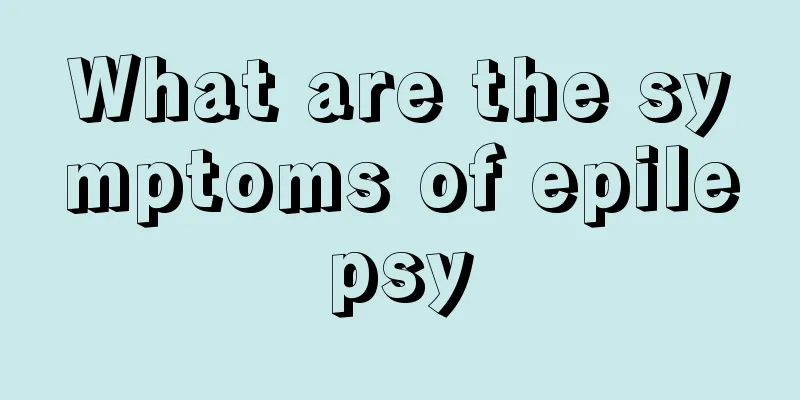What are the symptoms of epilepsy

|
The occurrence of epilepsy will have an impact on the patient's entire life. It often manifests as sudden loss of consciousness, followed by symptoms such as cyanosis of the face, urinary incontinence, foaming at the mouth, and dilated pupils. Some may even cause hallucinations, delusions, and self-harm and violent behavior. 1. Generalized tonic-clonic seizure (grand mal seizure): Sudden loss of consciousness, followed by tonic and then clonic convulsions, often accompanied by screaming, cyanosis, urinary incontinence, tongue biting, foaming at the mouth or blood, dilated pupils, which last for tens of seconds or minutes before the convulsion stops naturally and the patient enters a coma. After waking up, the patient has a short period of dizziness, irritability, and fatigue, and cannot recall the process of the seizure. If the seizure continues and the patient remains in a coma, it is called a grand mal seizure, which is often life-threatening. 2. Absence seizure (petit mal): sudden interruption of mental activity, loss of consciousness, may be accompanied by myoclonus or automatism, each seizure lasts from a few seconds to more than ten seconds, and the EEG shows a complex of slow spikes or slow waves 3 times per second. 3. Simple partial seizure: rigidity, clonic seizure, or paresthesia in a certain part or one side of the limbs, which lasts for a short time and the patient is conscious. If the seizure extends along the motor area to other limbs or the whole body, it may be accompanied by loss of consciousness, which is called Jackson seizure (Jack). After the seizure, the affected limb may be temporarily paralyzed, which is called Todd palsy. 4. Complex partial seizures (psychomotor seizures): Psychosomatic, psychomotor and mixed seizures, often with varying degrees of impaired consciousness and obvious thinking, perception, emotion and psychomotor disorders, may have automatisms such as fugue and sleepwalking, and sometimes violent behaviors such as hurting others and self-harm may occur under the control of hallucinations and delusions. 5. Autonomic nervous system seizures (diencephalic): may be headache type, abdominal pain type, limb pain type, syncope type or cardiovascular type, 6. Primary epilepsy refers to epilepsy without a clear cause, while secondary epilepsy refers to epilepsy caused by intracranial tumors, trauma, infection, parasitic diseases, cerebrovascular diseases, systemic metabolic diseases, etc. 7. Localized seizures are generally seen in patients with organic damage to the cerebral cortex, manifested as paroxysmal twitching or paresthesias at the corner of the mouth, fingers or toes on one side, which may spread to one side of the body. When the seizure affects both sides of the body, it may manifest as a grand mal seizure. 8. Complex partial seizures are accompanied by impaired consciousness and inability to recall the course of the seizure. They may also manifest as staring and automatisms such as smacking lips, chewing, groping, wandering, fiddling, humming, mumbling or other symptoms and signs. |
<<: What are the contraindications for arsenic poisoning?
>>: What to do if the cesarean section scar becomes hard
Recommend
Digesting too quickly makes you hungry
The digestive function of our stomach and intesti...
How to prevent bladder cancer
In recent years, bladder cancer has become one of...
8 tips for keeping your liver healthy in summer
Summer is here, is the dog days of summer far awa...
How to wash old oil stains on clothes
Clothes with old oil stains are very ugly, but af...
Head spin inheritance
If you can look at the top of your head, you will...
What should I do if I suddenly urinate blood? Treatment for hematuria
Hematuria is caused by an abnormal increase in re...
What happened to my swollen feet after chemotherapy for breast cancer?
What happens if my feet swell after chemotherapy ...
7 kinds of food are most effective in dealing with spring fatigue
Introduction : "Spring sleepiness" is a...
What's going on with the bulge under the chicken's neck?
People often eat chicken, but few people have act...
Can ovarian tumors cause infertility?
Will ovarian tumors cause infertility? Ovarian tu...
How to cut fruit beautifully
Everything should be good in color, aroma and tas...
What are the diagnostic methods for bladder cancer?
The most obvious early symptom of bladder cancer ...
What are the dangers of brain cancer to women
Brain cancer is a relatively serious tumor diseas...
Is lobster seafood?
Speaking of seafood products, it should resonate ...
The main cause of lung cancer
Lung cancer is a type of cancer with a very high ...









